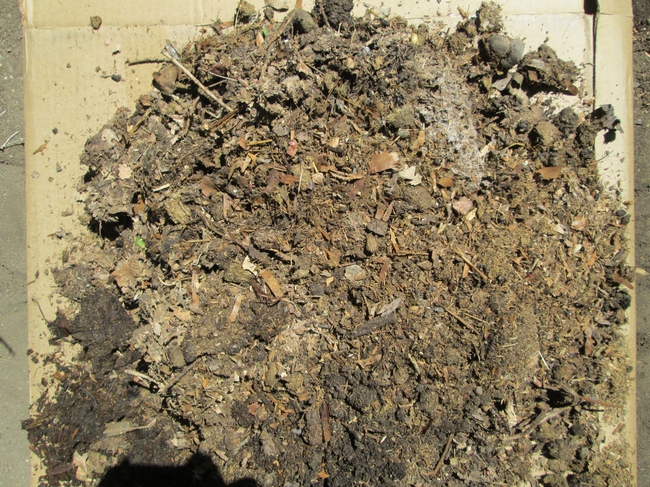In the last few years there has been an interest in “no till” methods of gardening that propose numerous benefits such as increased yields, less physical work, and much healthier soil cited as reasons we should stop digging our soils. However I wonder if this method of growing is really suited to the environs of desert areas? Here are some thoughts of mine on the issue.
Let's start with what “no till” growing is, and how does one go about doing it.
There is more than one way to accomplish a "no-till" garden but the most commonly advocated method is sheet mulching. (It goes by many names.) As the name suggests, the soil is not dug in preparation for growing food or ornamental plants but rather the top of the soil is regularly amended with organic matter which works its way down into the soil to feed the roots of the plants from above. To start a new growing bed using this method, a layer of cardboard is put over the surface of the ground in order to suppress existing weeds. Then a deep layer of well-rotted compost is laid over the top and crops are grown in this. Plants are mulched to retain moisture, and over time the cardboard rots and worms take the compost down into the native soil. This is considered to be closer to how plants and soils interact in the natural world.
By contrast, hand digging or rototilling disturbs the natural profile of the soil by destroying earthworm burrows and bringing the natural and beneficial mycorrhizae to the surface where ultraviolet light and drying conditions kill these fungi. It also interferes with the natural drainage of soil so dug soils drain poorly compared to the compost in no till beds and soil loss by wind erosion is increased.
There is a lot to be said in favor of the no till method. However, is a no-till method like sheet mulching suitable for desert situations with a very low natural rainfall? Most of those who advocate this method of growing and have the greatest success live in high rainfall areas where precipitation is regular throughout the year, and often the rainfall each month is as much as our desert area receives in a year! We also have very dry air with a relative humidity often less than 10%, with frequent, quite strong, drying winds. Our natural vegetation is sparse and prickly as a result of the climate, and things decompose very slowly.
Beneficial to the soil as “no till” might be, some arguments in favor do not hold up in our area. Supposedly it is less labor intensive since one does not dig, but to produce the amounts of compost needed in our area for this method to work, one either has to constantly turn compost heaps, or else buy compost in bulk (assuming that you can find a local source), pay for it to be delivered and then barrow it to the growing area! Our environment makes it hard to even acquire something to make compost from in sufficient amounts.
Then there is the tremendous water usage, both for keeping one's compost heap working and then keeping the applied compost damp enough for these benefits to occur in the garden. Everything dries quickly in our wind, sun, and heat.
Mulch such as wood chips takes a long time to rot down in the desert but without some protection our desert winds can certainly remove loose topsoil. In my experience they are equally efficient at removing the finer particles of mulch, leaving only the sticks behind. Often I have put a deep layer of shredded leaves around plants and on top of the drip irrigation tubing but this fine mulch, far from rotting down or being taken into the soil by accommodating earthworms has rapidly vanished into the next county during our high wind events. This does not happen so much if the mulch surface is kept wet, but can we afford to use that much water when facing a serious drought?
When digging I always incorporate generous amounts of compost or manure or any remaining surface mulch into the ground where it will not get blown away and will be in close proximity to the roots of my crops. I dig in winter when earthworms are very deep in the soil but by spring I have an extremely healthy population.
In many places in the desert where the soils are sandy and alkaline, earthworms are a rarity - if present at all, so in these cases the downward movement of organic matter placed on the surface is not likely to happen for several seasons, and indeed where I have raked several year's accumulation of leaves from under shrubs, even the bottom layer hardly shows any evidence of the leaves breaking down.
No till's proponents admit that slugs and snails are common problems in the compost-grown vegetables, although I doubt whether that would be much of a problem here, but I did mulch heavily with straw one year and consequently had the worst European earwig infestation that I have ever experienced.
Our desert soils certainly need a lot of help in the form of organic matter if they are to produce crops, but it is difficult to know which is the best way to achieve that. As with most horticultural endeavors there are pros and cons to both methods but it pays to think of different options, and perhaps do a trial bed before embarking either method on a large scale.
____
Editor's note: Another consideration is the population of weeds present. At least in the Owens Valley, our perennial weeds, especially Bermudagrass, emerge through the cardboard layer quickly since it is insufficient to stop them. A gardener would have to eliminate perennial weeds first. Our wind also brings in fresh seeds of wind-dispersed annual weeds that grow well in the rich, organic layer.
